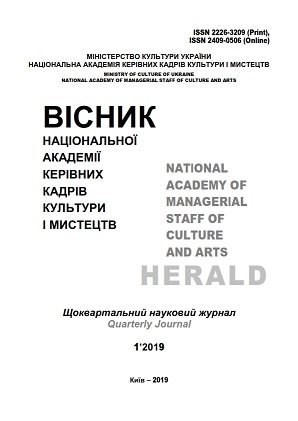Особливості візуальних репрезентацій української культури в соціальних мережах
Peculiarities of Visual Representations of Ukrainian Culture in Social Networks
Author(s): Konstiantyn Volodymyrovych KysliukSubject(s): Culture and social structure , Social Informatics, Sociology of Culture
Published by: Національна академія керівних кадрів культури і мистецтв
Keywords: visual representations; Instagram; social networks; Ukrainian culture; Facebook;
Summary/Abstract: The Purpose of the article: to establish the peculiarities of visual representations of Ukrainian culture in social networks – Instagram and Facebook. The methodology included: 1) content-analysis of visual arrays, 2) comparative analysis of the obtained results and 3) their cultural interpretations. The total sample size was more than 3,5 thousand units. Scientific novelty: clarification of the question — with which Ukraine visually identifies itself, it allows us to clarify the author's conception of the multifaceted «borderline» of Ukrainian culture as a consequence of the inconsistent and stretched in time modernization, and not the classical «statelessness». Conclusions: in the visual content of Instagram and Facebook, various ways of self-identification of Ukrainian culture have been implemented — civil-political and ethnocultural. In the civil-political version, the national specificity of Ukraine, in general, does not occur. In the ethnocultural version, feminized and rasterized images of Ukraine (women in national dress, yellow-blue colored spectrum, ripe wheat or sunflower fields) had prevailed. They can be determined as archaic. Artificial masculinization of the image of the country (Cossacks, heroes of the national liberation struggle) in the public consciousness is not tired. According to the standard of permanent availability (but not the frequency of placement), the Monument of Independence was designated as the leading memorial symbol of Ukraine in 1990–2010. In the photographs of the largest Ukrainian cities, the number of «non-modern» urban landscapes overwhelmingly prevailed «modern». Among the Ukrainian megacities, the most modernized were Kiev and Dnipro, Odessa and Kharkiv were visually represented most conservatively.
Journal: Вісник Національної академії керівних кадрів культури і мистецтв
- Issue Year: 2019
- Issue No: 1
- Page Range: 55-59
- Page Count: 5
- Language: Ukrainian

